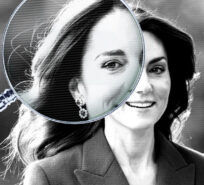There I was, legs elevated in metal stirrups, counting backward from ten, losing consciousness by the second. Why? For $7K… duh.
There’s not much I won’t consider doing for money. As a kid, I worked a lemonade stand, sold snacks at yard sales, and scammed grown-ups with bets like $20 for throwing an inflated football through a tire. I’ve had an array of jobs since I was 16 and almost never just one at a time. I was even offered $200 in high school to take a guy’s virginity. I didn’t, but does that matter?
Donating your eggs is not easy money, but that is the illusion.
Just the lengthy application alone can weed out the weary. Then you have to get over the fear of stabbing yourself with needles, followed by the realization that you might release children into the world. It’s enough to make anyone think twice.
Obviously, money is a primary motivator when it comes to a procedure like this. A study published in the U.S. National Library of Medicine notes that 81% of egg donors “indicated that the offer of payment was significant to their decision.” Yet, I found that the end result was way more rewarding than the cash, and that’s why I donated my eggs not once, but twice. The money is long gone. After Uncle Sam reached between my legs for a quarter of it, I used the rest to leave a job I hated, pay off debt, and buy myself some boobs. But when I look back on my donation process, it’s not the money I remember.
First, it’s important to clear up a common misconception: Donating doesn’t affect your egg count. According to the Cleveland Clinic, women are born with approximately one million eggs. Even prior to puberty, these eggs die each month. So the eggs you donate would naturally die in your next menstrual cycle.
Thrust into living alone after my boyfriend broke up with me unexpectedly, my credit card became a crutch. I couldn’t get through the week without dipping into unpromised money. A friend of mine introduced me to Shady Grove Fertility, an organization dedicated to infertility treatments. She had considered donating her eggs but was daunted by the application process due to her family medical history. Less than 40% of applicants pass the initial screening, a statistic specific to SGF provided to me upon completion. I answered the preliminary application, which consisted of a few essential questions used to easily disqualify any red flags—one of which I held. I had traveled to the Caribbean with my ex (eye roll) just five months prior and ZIKA was a major concern. I was asked to apply again in another month, since six months was the threshold for exposure.
After re-applying, I was accepted and provided a link for the comprehensive application. Holy Moly. Now, I’m a writer and fully enjoy talking about myself, but this was on another level. I provided personal statements and short essays about everything down to my musical ability and every detail about my family including the color of my dead paternal grandfather’s eyes. The application actually serves as a profile for a donor when they are being selected by hopeful recipients. I uploaded pictures of myself as a child and an adult—the latter is not required but increases the probability and rate of being chosen.
I was then invited to begin the medical screening portion. Based on when I had started my most recent pack of birth control, an ultrasound and bloodwork appointment were scheduled. They also performed genetic screening which tested for 105 conditions. At this point, it had been about three months since I first reached out. I received $150 through an application promotion and $50 for approved lab work.
*calls produce manager of whole foods* hi yes i’m interested in donating my eggs
— you thoughtttttttttttttttttttttttt (@youonebigyike) September 1, 2019
I took a brief online course that provided an overview of the procedure and then was scheduled for “Donor Day,” which requires a day off from work when current donors meet at the office with a nurse for in-person training and screening. After screening, we took a 150 question multiple choice personality test, learned about the procedure, ate pizza, and practiced our first injection. We practiced mixing solution, dialing the pen to the correct dosage, and finally pinching some stomach fat and stabbing ourselves. I bled, which never happened again, but I had my first “what have I done?” moment. The day earned me $450.
Then, I signed consent forms and met with a social worker. Basically, it was a therapy session to ensure my sanity and comfort with the process, especially the fact that this would likely result in real live children running around with my DNA. I was and am completely comfortable with this fact. Once cleared, my profile went live for recipients to view. I was selected within a week. They switched my birth control in order to sync with my recipient’s and I received fertility medication to my home.
No more drinking, sex, drugs, tattoos, piercings, smoking, etc. Over the next two weeks, I injected hormones into my stomach at the same time each night and went into the office for bloodwork and an ultrasound about three times a week. The one shot, which I administered through an insulin pen, didn’t bother me. But the second shot, which required mixing a powder and liquid, burned as I pressed the plunger releasing the solution under my skin. You get used to it, but I always dreaded the second shot. The medication grows the egg follicles, and the ultrasound measures that growth process. With a lubed-up wand between my legs, I watched my uterus morph into a crop field on a blurry screen, and it was fascinating. My monitoring visits increased with my follicle size. Eventually, I added a third shot to my daily routine. The nurses followed my progress and emailed me with specific dosing instructions as they changed.

One of the childhood photos I used in my egg donor profile
All of the coordinators, nurses, and doctors I worked with throughout the process were incredibly helpful. They answered my questions, wrote me a note to freeze my gym membership, and even worked around the travel required for my job, scheduling me at locations that were convenient to my home, office, and wherever I was traveling. And yes, I did this while working for an event production company (one of my bosses had actually used a donor herself). I brought my medication in a cooler and took strategic breaks so that I could shuttle to an offsite condo where I’d disappear into the bathroom with my needles.
I actually relished the time that preceded the retrieval procedure. My body felt productive, like a factory. I was preparing for this really important gift while still working full time and living my life. Around three days out, I could actually feel my ovaries sloshing beneath my pelvis. The hormones swell each ovary from the size of a ping-pong ball to that of an orange.
After about two weeks, monitoring took place every day and they watched my progress closely to determine the exact date and time of retrieval. My mom was on standby to come stay and drive me to and from surgery. Once a date was defined (about two days out) I was instructed to take my trigger shot at a very specific time two nights before retrieval. I also took an antibiotic the night before with no food or water following.
My mom and I woke at 4am and drove to the surgery center 45 minutes away. I started to cramp. The building was immaculate. I felt very safe and comfortable. The staff was warm and attentive and kept thanking me for my “gift”. They also handed me a check for $6,500.
I dressed in some fabulous surgery attire (booties, gown, hair net) and received an IV. The cramping started to increase minutes away from surgery. I received anesthesia through my IV. Aside from having my wisdom teeth extracted, this was my first surgery. I walked with my IV tree and a nurse to the procedure room. I laid on a table and lifted my legs into metal stirrups. For the first time, I suddenly felt incredibly exposed. The anesthesiologist placed a gas mask over my nose and mouth and before I knew it, I was asleep. While I was out, a long needle-like vacuum was inserted into my vagina and pierced the vaginal wall on each side to essentially suck out the eggs from each of my ovaries. They retrieved 13 mature eggs. The actual retrieval only took about 20 minutes.
The drive back to Baltimore was rough. I wanted to sleep, but the bumpy roads aggravated the cramping. Plus, my ovaries were still enlarged. I slept when I got home and watched Fixer Upper for the rest of the day. The doctor gave me a prescription for pain that I ended up not needing. By that night, I felt back to normal. I stayed home from work the next day because why not, ya know? I returned for a follow-up visit about a week later and I was on my way! I had sex the following weekend even though I shouldn’t have. But I missed alcohol and d*ck. TG for Plan B.

I included a number of childhood and adult photos for my donor profile.
SGF reached out to me about three months later encouraging me to donate again. Although hesitant at first, I excitedly agreed. Since I was already vetted, the process proceeded much quicker—only about two months. They completed an initial screening before reactivating my donor profile. Unlike the first time, my profile was selected by three families instead of just one and my retrieval was split amongst them.
Things went even smoother the second time around. And not just because I knew the ropes, but because my body did too. I hardly experienced any cramping before and after surgery. They retrieved 22 mature eggs the second time and I received a total of $7,500.
I haven’t donated a third time (worth $8k) for a few reasons. Honestly, I’m nervous to jinx myself. The last thing I want is for something to hinder my ability to have my own children in the future. Another reason, which I only thought of more recently, is that I plan to stay in the Baltimore area as I have my own kids. This sounds like the plot to a titillating beach read, but my future kids could very well meet and date my donor children. One reason women aren’t allowed to donate more than six times with one organization is for this very reason.
Moral of the story: egg donation is incredibly involved, but it’s an extraordinary way to help a fellow human. If you made it to the end of this whirlwind article and are still interested in donating, do as much research as you can, especially as it pertains to the options in your area. Really consider the possibility of a child seeking you out in the future. Although the information is private, we all see the leaps and bounds DNA technology have already made. If you have more questions about my experience, feel free to DM me. Although I don’t plan to continue donating, I’d love to facilitate that opportunity for others.
Images: Kara Kinnamon (2); Nikola Radojcic / Unsplash; SGFertility, youonebigyike / Twitter







































